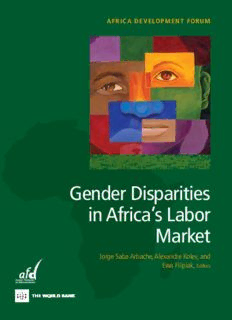Table Of ContentAFRICA DEVELOPMENT FORUM
Gender Disparities
in Africa’s Labor
Market
Jorge Saba Arbache, Alexandre Kolev, and
Ewa Filipiak, Editors
Gender Disparities in
Africa’s Labor Market
Gender Disparities in
Africa’s Labor Market
Jorge Saba Arbache, Alexandre Kolev,
and Ewa Filipiak
Editors
A copublication of the Agence Française de Développement and the World Bank
© 2010 The International Bank for Reconstruction and Development / The World Bank
1818 H Street NW
Washington DC 20433
Telephone: 202-473-1000
Internet: www.worldbank.org
E-mail: [email protected]
All rights reserved
1 2 3 4 13 12 11 10
This volume is a product of the staff of the International Bank for Reconstruction and Devel-
opment / The World Bank. The fi ndings, interpretations, and conclusions expressed in this
volume do not necessarily refl ect the views of the Executive Directors of The World Bank or
the governments they represent.
The World Bank does not guarantee the accuracy of the data included in this work. The
boundaries, colors, denominations, and other information shown on any map in this work
do not imply any judgement on the part of The World Bank concerning the legal status of any
territory or the endorsement or acceptance of such boundaries.
Rights and Permissions
The material in this publication is copyrighted. Copying and/or transmitting portions or all
of this work without permission may be a violation of applicable law. The International Bank
for Reconstruction and Development / The World Bank encourages dissemination of its work
and will normally grant permission to reproduce portions of the work promptly.
For permission to photocopy or reprint any part of this work, please send a request with
complete information to the Copyright Clearance Center Inc., 222 Rosewood Drive, Danvers,
MA 01923, USA; telephone: 978-750-8400; fax: 978-750-4470; Internet: www.copyright.com.
All other queries on rights and licenses, including subsidiary rights, should be addressed
to the Offi ce of the Publisher, The World Bank, 1818 H Street NW, Washington, DC 20433,
USA; fax: 202-522-2422; e-mail: [email protected].
ISBN: 978-0-8213-8066-6
eISBN: 978-0-8213-8070-3
DOI: 10.1596/978-0-8213-8066-6
Library of Congress Cataloging-in-Publication Data
Gender disparities in Africa’s labor market / Jorge Saba Arbache, Alexandre Kolev, and Ewa
Filipiak, editors.
p. cm.
ISBN 978-0-8213-8066-6 — ISBN 978-0-8213-8070-3 (ebook)
1. Sex discrimination in employment—Africa. 2. Sexual division of labor—Africa. 3. Labor
market—Africa. I. Arbache, Jorge Saba. II. Kolev, Alexandre. III. Filipiak, Ewa. IV. World Bank.
HD6060.5.A35G46 2010
331.4'133096—dc22
2010014200
Cover photo: Corbis
Cover design: Naylor Design, Washington, DC
Africa Development Forum Series
The Africa Development Forum series was created in 2009 to focus on issues of
signifi cant relevance to Sub-Saharan Africa’s social and economic development.
Its aim is both to record the state of the art on a specifi c topic and to contribute
to ongoing local, regional, and global policy debates. It is designed specifi cally to
provide practitioners, scholars, and students with the most up-to-date research
results while highlighting the promise, challenges, and opportunities that exist
on the continent.
The series is sponsored by the Agence Française de Développement and the
World Bank. The manuscripts chosen for publication represent the highest
quality in each institution’s research and activity output and have been selected
for their relevance to the development agenda. Working together with a shared
sense of mission and interdisciplinary purpose, the two institutions are com-
mitted to a common search for new insights and new ways of analyzing the
development realities of the Sub-Saharan Africa Region.
Advisory Committee Members
Agence Française de Développement
Pierre Jacquet, Directeur de la Stratégie et Chef Économiste
Robert Peccoud, Directeur de la Recherche
World Bank
Shantayanan Devarajan, Chief Economist, Africa Region
Jorge Arbache, Senior Economist
Contents
Foreword xix
About the Editors and Authors xxi
Acknowledgments xxv
Abbreviations xxvii
Overview
Why Study Gender Disparities in Africa’s Labor Markets? 1
Jorge Saba Arbache, Ewa Filipiak, and Alexandre Kolev
Objective of This Book 2
Countries Covered in the Studies 3
Book Organization and Topics 5
The Main Findings on Gender Disparities in Africa 8
Policy Recommendations and the Way Forward 16
PART 1 STYLIZED FACTS 21
1 Gender Disparities in Africa’s Labor Markets: A Cross-
Country Comparison Using Standardized Survey Data 23
Alexandre Kolev and Nicolas Sirven
Data and Concepts 24
Gender Differences in Labor Market Outcomes 27
Gender Disparities at Work 36
vii
viii Contents
The Role of Educational Attainment and Gender
Inequalities in Education 42
Conclusions 49
Annex 51
PART 2 DISPARITIES IN EMPLOYMENT, PAY, EDUCATION,
AND OTHER DIMENSIONS: A MICRO-ANALYSIS 55
2 Exploring the Gender Pay Gap Through Different
Age Cohorts: The Case of Ethiopia 57
Alexandre Kolev and Pablo Suárez Robles
Data and Concepts 58
Methodology 62
Results 65
Conclusions 70
Annex 72
3 Gender Disparities in the Malagasy Labor Market 87
Christophe J. Nordman, Faly Rakotomanana,
and Anne-Sophie Robilliard
Characteristics of the Malagasy Labor Market 91
Data, Defi nitions, and Methods 92
Results 94
Summary and Concluding Remarks 109
Annex 3A Concepts and Methods 113
Annex 3B Summary Statistics of the Variables
Used in the Econometric Analysis 120
Annex 3C Determinants of Sectoral Allocation 122
Annex 3D Wage Employment Earnings Equations 134
Annex 3E Earnings Gap Decompositions for
Wage Workers 144
4 Gender Differences in Pay in African Manufacturing Firms 155
Christophe J. Nordman and François-Charles Wolff
Data and Descriptive Statistics 158
Description:Gender inequality in the labor market remains a pressing problem of contemporary Africa. Notwithstanding the existence of large variations across countries with regard to male and female labor market outcomes, available evidence shows that in several countries of the region women are less likely to

